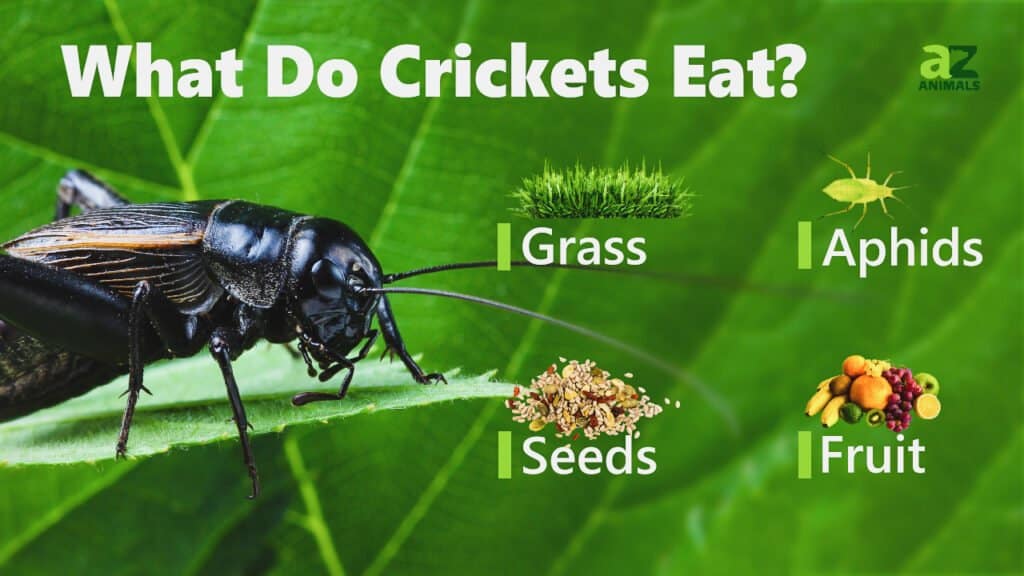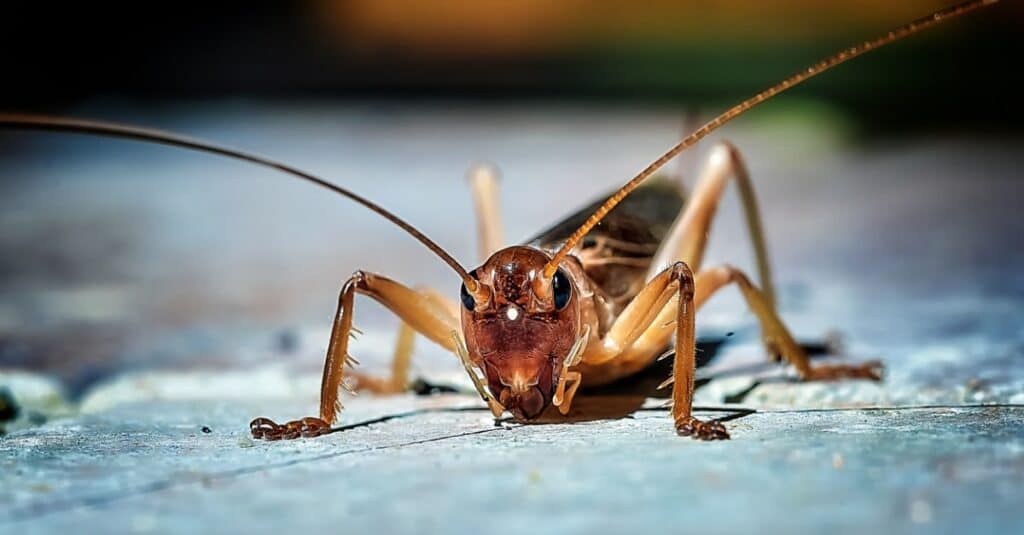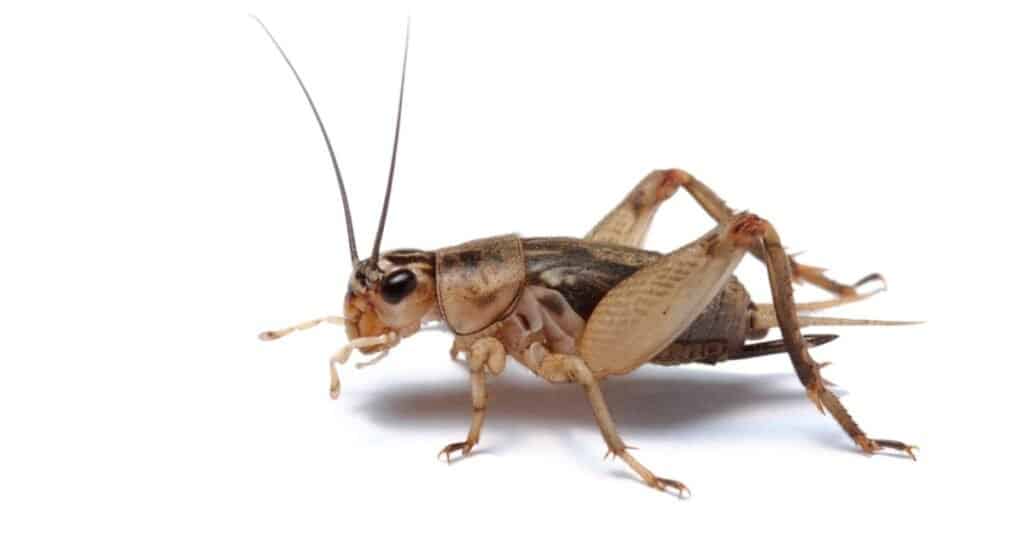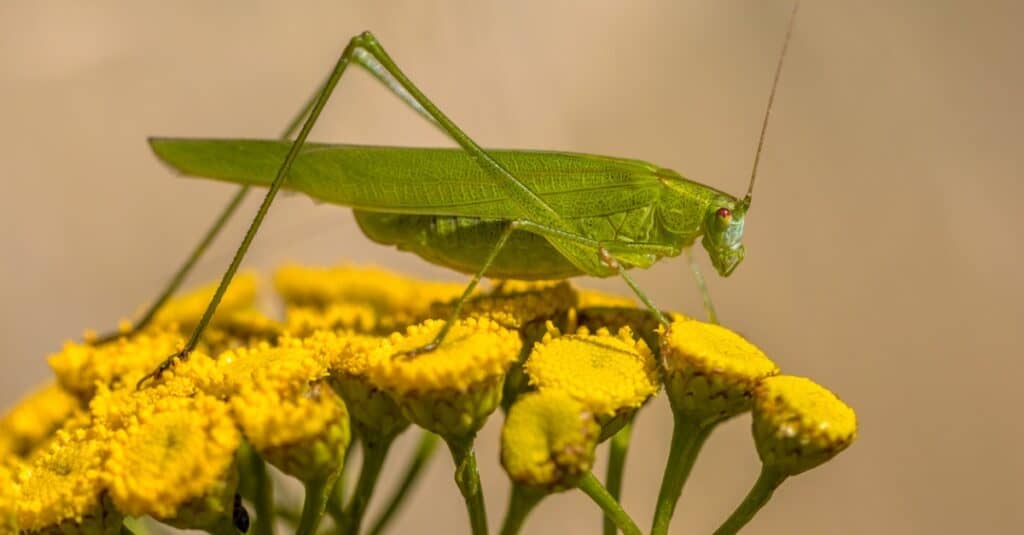What Do Crickets Eat?
Crickets belong to the order Orthoptera, which also includes grasshoppers and locusts. Maybe people often mistake crickets for grasshoppers, which is easy to understand. These small, cylindrical insects possess round heads and long antennae. While they can fly using their wings, they are more likely to jump using their strong hind legs. You’ve likely seen crickets jumping around your yard or on the sidewalk, particularly at night. Additionally, you’ve maybe heard crickets chirping at night, a sound they make by rubbing their wings together. This sound is made by the males, which chirp to attract females. You can find crickets around the world on every continent except in Antarctica. They live in varied habitats, particularly the tropics, and are well adapted to most environments. You likely know a lot about crickets. That said, do you know the answer to the question, “what do crickets eat?”
In this article, we’ll attempt to answer this question for you in detail. First, we’ll start off by talking about what crickets like to eat. Next, we’ll discuss how cricketers hunt and forage for food. We’ll then compare what crickets eat in the wild versus what they eat in captivity. Finally, we’ll end with a brief conversation about what baby crickets eat. So, let’s jump right in and get started answering the question “what do crickets eat?”
What Do Crickets Like to Eat?

A-Z-Animals.com
Crickets eat a wide variety of foodstuffs, and their diet can change depending on the species. In total, there are more than 900 species of cricket, with nearly 100 located in the United States alone. Some crickets are omnivorous, meaning they eat both plant and animal matter. Others are herbivorous and live on a diet of mostly plants. Still, others are primarily predators and live mostly off of other insects and animals. Additionally, some crickets act as scavengers, mostly eating decaying organic material that they find. The diets of captive crickets are also quite different from the diets of wild crickets. That said, it’s impossible to create a list of foods that all crickets like to eat. Instead, we’ll list 12 foods commonly eaten by crickets. These foods occur frequently on the lists of foods that crickets eat. They include:
- Flowers
- Fruit
- Leaves
- Grass
- Shoots
- Eggs
- Larvae
- Insects
- Aphids
- Seeds
- Decaying matter
- Fungi
How Do Crickets Hunt and Forage For Food?

iStock.com/tracielouise
Crickets possess the same five senses as humans, although they rely on different senses to find food and use their senses in unique ways. First, crickets have excellent eyesight. They possess large compound eyes that enable them to focus on different images at the same time. Their keen vision helps them to find food and also to keep track of moving prey. Crickets also have a keen sense of smell. With their antenna, they can detect pheromones and other odors, which helps them to detect food. Using their tympana in their legs, they can hear sounds and detect vibrations through the ground around them. Additionally, crickets possess taste buds in their mouths, although they are not as advanced as those in our mouths. Finally, crickets’ bodies are covered in tiny hairs. These hairs act as touch receptors and allow them to take in information from their environment.
Crickets employ different tactics to find food depending on their species and environment. Herbivorous crickets are primarily foragers, meaning that they spend most of their time grazing. They move from plant to plant chewing on leaves, shoots, and flowers. On the other hand, some crickets are primarily carnivorous. These crickets act as predators, preying on other smaller insects. Many crickets possess natural camouflage, which aids them in hunting. They’ll leap onto their unsuspecting prey using their large, strong legs, catching their prey unawares. Once they’ve caught their prey, they’ll bite and consume their food using their powerful jaws. Meanwhile, other crickets obtain their food primarily via scavenging. They use their sense of smell to detect the scent of dead or decaying plant and animal matter. In all these ways, crickets rely on their survival instincts and senses to find food in their habitat.
What Do Crickets Eat in the Wild?

iStock.com/PetrP
In the wild, crickets eat a wide variety of foods. Their diets vary based upon the species, the environment, and the season. Herbivorous crickets primarily eat things like grasses, fruits, and flowers. They will also eat seeds and seedlings, as well as the shoots of young plants. On the other hand, carnivorous crickets mostly eat other animals. They will target smaller insects, as well as pupae and larvae. In particular, aphids are one of crickets’ favorite prey. Crickets love to target these small sap-sucking insects and will eat them in large numbers. Their diet also includes the eggs of other invertebrates. Meanwhile, omnivorous insects eat both plant and animal matter. On the other hand, scavenging insects prefer dead and decaying organic matter. They will target things like fungi, decaying plants, carrion, and seedlings. That said, crickets will eat just about anything that they can find.
What Do Captive Crickets Eat?

iStock.com/CreativeNature_nl
Many people decide to keep crickets as pets. Some raise them for entertainment value, while others raise them as feed for other animals and insects. If you decide to raise crickets as pets, you’ll need to know what to feed them to keep them healthy. That said, crickets are highly adaptable insects. When raised in captivity, they can learn to eat just about anything to survive. In captivity, main species have learned to thrive on a diet of pet food, such as dog kibble. However, these crickets usually also receive fresh veggies such as lettuce as well as aphids in their diet. Herbivorous crickets can thrive on a diet of fruits like apples, oranges, and bananas, and vegetables like potatoes, carrots, and greens. Carnivorous crickets will need things like aphids, ants, ladybugs, and other small insects. It’s all about knowing what your pet cricket needs to survive.
What Do Baby Crickets Eat?

Alexander Sviridov/Shutterstock.com
Baby crickets, or nymphs, are the juvenile stage of a cricket’s life cycle. Once they emerge from an egg, most crickets spend around half their life as nymphs. On average, a cricket will spend around 6 weeks as a nymph, and around the same time as an adult. In the wild, nymphs eat a wide variety of food. They are voracious eaters and eat a wider variety of foods than adult crickets. Nymphs will eat just about anything they can find, including plant and animal matter and decaying matter. Their diet includes things like weeds, grasses, seedlings, grains, fruits, flowers, and other insects. Due to their dietary habits, they can pose a threat to domestic crops when gathered in large numbers. This has led to many farmers and gardeners viewing crickets as pests.
More from A-Z Animals
Crickets belong to the order Orthoptera, which also includes grasshoppers and locusts. Maybe people often mistake crickets for grasshoppers, which is easy to understand. These small, cylindrical insects possess round heads and long antennae. While they can fly using their wings, they are more likely to jump using their strong hind legs. You’ve likely seen crickets jumping around your yard or on the sidewalk, particularly at night. Additionally, you’ve maybe heard crickets chirping at night, a sound they make by rubbing their wings together. This sound is made by the males, which chirp to attract females. You can find crickets around the world on every continent except in Antarctica. They live in varied habitats, particularly the tropics, and are well adapted to most environments. You likely know a lot about crickets. That said, do you know the answer to the question, “what do crickets eat?”
In this article, we’ll attempt to answer this question for you in detail. First, we’ll start off by talking about what crickets like to eat. Next, we’ll discuss how cricketers hunt and forage for food. We’ll then compare what crickets eat in the wild versus what they eat in captivity. Finally, we’ll end with a brief conversation about what baby crickets eat. So, let’s jump right in and get started answering the question “what do crickets eat?”
What Do Crickets Like to Eat?

A-Z-Animals.com
Crickets eat a wide variety of foodstuffs, and their diet can change depending on the species. In total, there are more than 900 species of cricket, with nearly 100 located in the United States alone. Some crickets are omnivorous, meaning they eat both plant and animal matter. Others are herbivorous and live on a diet of mostly plants. Still, others are primarily predators and live mostly off of other insects and animals. Additionally, some crickets act as scavengers, mostly eating decaying organic material that they find. The diets of captive crickets are also quite different from the diets of wild crickets. That said, it’s impossible to create a list of foods that all crickets like to eat. Instead, we’ll list 12 foods commonly eaten by crickets. These foods occur frequently on the lists of foods that crickets eat. They include:
- Flowers
- Fruit
- Leaves
- Grass
- Shoots
- Eggs
- Larvae
- Insects
- Aphids
- Seeds
- Decaying matter
- Fungi
How Do Crickets Hunt and Forage For Food?

iStock.com/tracielouise
Crickets possess the same five senses as humans, although they rely on different senses to find food and use their senses in unique ways. First, crickets have excellent eyesight. They possess large compound eyes that enable them to focus on different images at the same time. Their keen vision helps them to find food and also to keep track of moving prey. Crickets also have a keen sense of smell. With their antenna, they can detect pheromones and other odors, which helps them to detect food. Using their tympana in their legs, they can hear sounds and detect vibrations through the ground around them. Additionally, crickets possess taste buds in their mouths, although they are not as advanced as those in our mouths. Finally, crickets’ bodies are covered in tiny hairs. These hairs act as touch receptors and allow them to take in information from their environment.
Crickets employ different tactics to find food depending on their species and environment. Herbivorous crickets are primarily foragers, meaning that they spend most of their time grazing. They move from plant to plant chewing on leaves, shoots, and flowers. On the other hand, some crickets are primarily carnivorous. These crickets act as predators, preying on other smaller insects. Many crickets possess natural camouflage, which aids them in hunting. They’ll leap onto their unsuspecting prey using their large, strong legs, catching their prey unawares. Once they’ve caught their prey, they’ll bite and consume their food using their powerful jaws. Meanwhile, other crickets obtain their food primarily via scavenging. They use their sense of smell to detect the scent of dead or decaying plant and animal matter. In all these ways, crickets rely on their survival instincts and senses to find food in their habitat.
What Do Crickets Eat in the Wild?

iStock.com/PetrP
In the wild, crickets eat a wide variety of foods. Their diets vary based upon the species, the environment, and the season. Herbivorous crickets primarily eat things like grasses, fruits, and flowers. They will also eat seeds and seedlings, as well as the shoots of young plants. On the other hand, carnivorous crickets mostly eat other animals. They will target smaller insects, as well as pupae and larvae. In particular, aphids are one of crickets’ favorite prey. Crickets love to target these small sap-sucking insects and will eat them in large numbers. Their diet also includes the eggs of other invertebrates. Meanwhile, omnivorous insects eat both plant and animal matter. On the other hand, scavenging insects prefer dead and decaying organic matter. They will target things like fungi, decaying plants, carrion, and seedlings. That said, crickets will eat just about anything that they can find.
What Do Captive Crickets Eat?

iStock.com/CreativeNature_nl
Many people decide to keep crickets as pets. Some raise them for entertainment value, while others raise them as feed for other animals and insects. If you decide to raise crickets as pets, you’ll need to know what to feed them to keep them healthy. That said, crickets are highly adaptable insects. When raised in captivity, they can learn to eat just about anything to survive. In captivity, main species have learned to thrive on a diet of pet food, such as dog kibble. However, these crickets usually also receive fresh veggies such as lettuce as well as aphids in their diet. Herbivorous crickets can thrive on a diet of fruits like apples, oranges, and bananas, and vegetables like potatoes, carrots, and greens. Carnivorous crickets will need things like aphids, ants, ladybugs, and other small insects. It’s all about knowing what your pet cricket needs to survive.
What Do Baby Crickets Eat?

Alexander Sviridov/Shutterstock.com
Baby crickets, or nymphs, are the juvenile stage of a cricket’s life cycle. Once they emerge from an egg, most crickets spend around half their life as nymphs. On average, a cricket will spend around 6 weeks as a nymph, and around the same time as an adult. In the wild, nymphs eat a wide variety of food. They are voracious eaters and eat a wider variety of foods than adult crickets. Nymphs will eat just about anything they can find, including plant and animal matter and decaying matter. Their diet includes things like weeds, grasses, seedlings, grains, fruits, flowers, and other insects. Due to their dietary habits, they can pose a threat to domestic crops when gathered in large numbers. This has led to many farmers and gardeners viewing crickets as pests.






